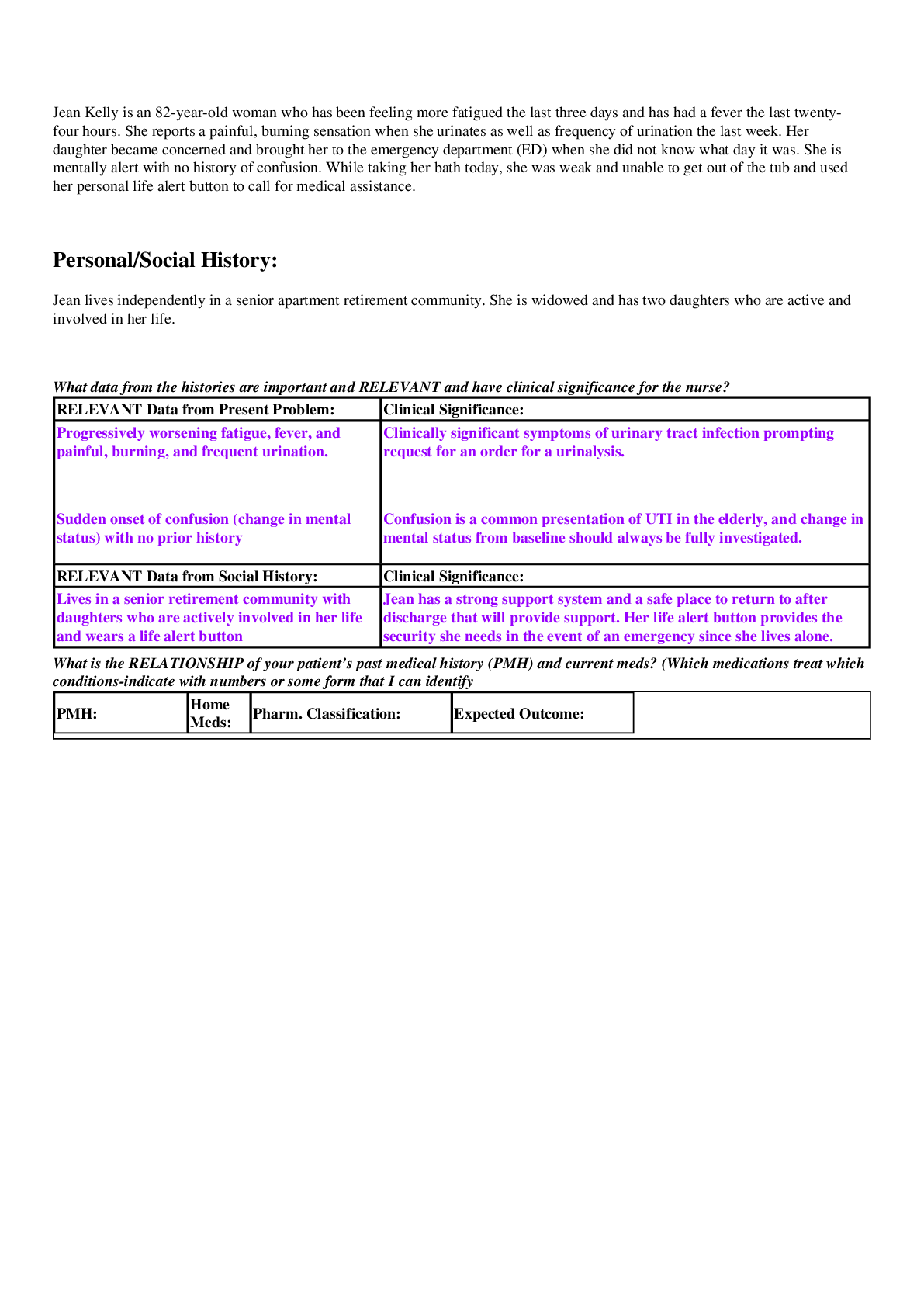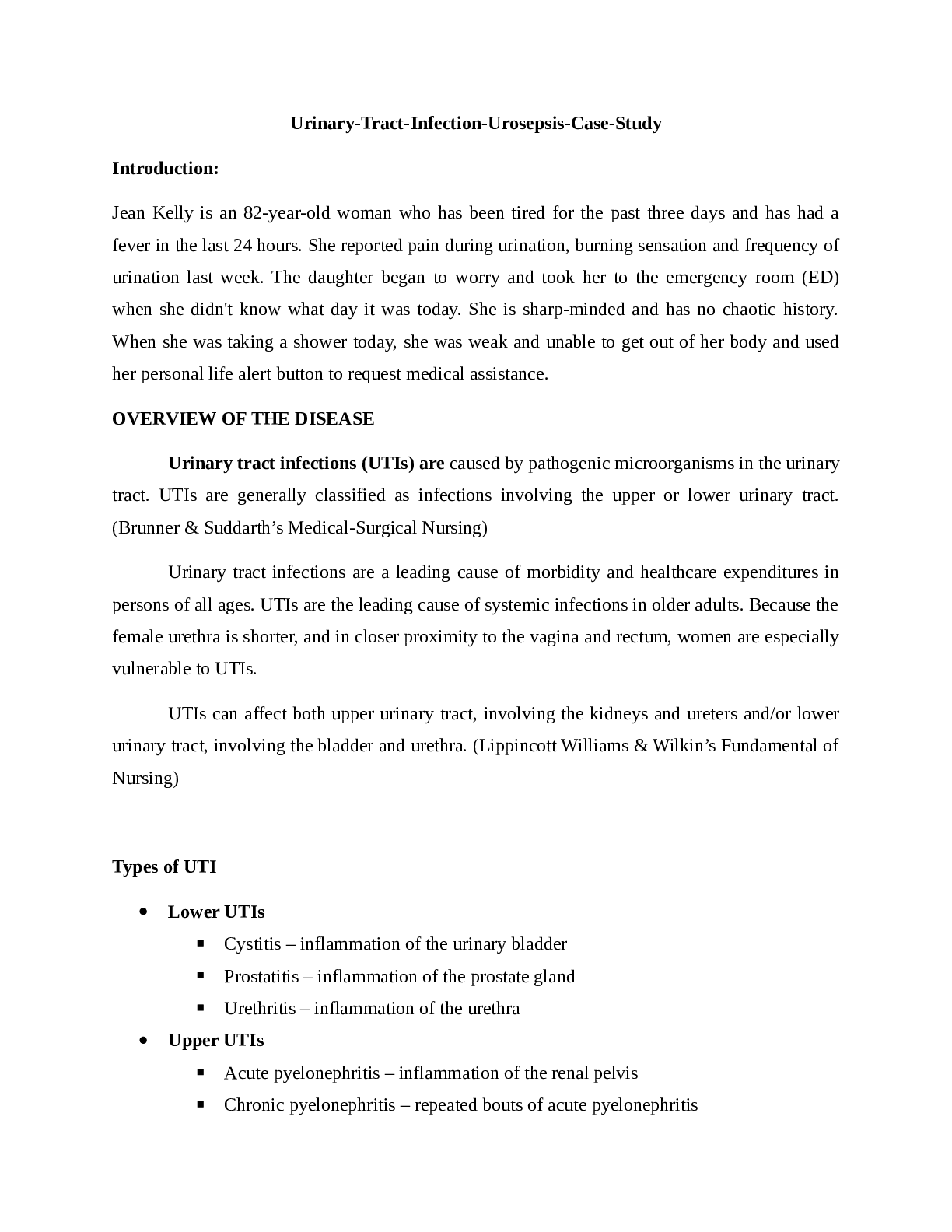Bundle > PH/NURS/NUFS 135: Health in a Multicultural Society> NUFS 135Final Exam/research paper
PH/NURS/NUFS 135: Health in a Multicultural Society> NUFS 135Final Exam/research paper
Individual Research Paper “The complex whole which includes beliefs, art, knowledge, morals, law, custom, and any other capabilities and habits acquired by [man] as a member of society” (Tylor, ... 1871). “The set of learned behaviors, beliefs, attitudes, values, and ideals that are characteristic of a particular society or population” (Ritter & Graham, 2017). “An inherited lens through which the individual perceives and understands the world that [he] inhabits and learns to live within” (Helman, 2000). “Within a group, what everybody knows that everybody else knows” (Sleeter & Grant, 1988). The Individual Research Paper assignment asks you to identify a cultural group that you identify with and explore a disparity that the group experiences using data to describe and define the disparity, including comparisons to other groups (without that last piece it wouldn’t be a disparity, just a health outcome). This in-depth analysis of the health disparity in a specific cultural group should be 8-10 pages long (not including cover page, references, and attachments), and address the following components I. Choose a cultural group that you feel you have an active identity around or involvement with and provide some background on the culture: • Describe your relationship to this culture. • Provide historical context for the culture, including its origins and key developments that have helped shape the culture and the experience of its members, including challenges to social justice and equity. • Membership demographics and characteristics – who makes up this culture, such as nationality, race/ethnicity, spirituality/religion, and location. II. Identify and describe a disparity experienced by this group. This can be a health disparity which is a higher burden of illness, injury, disability, or mortality experienced by one group relative to another, a health care disparity which typically refers to differences between groups in health insurance coverage, access to and use of care, and quality of culturally appropriate care (KFF, 2018) or a disparity in the social determinants of health such as access to quality education or housing and how that Final Exam The COVID-19 pandemic has provided opportunities for health professionals to see the outcomes of social inequities and disparities through the lens of COVID 19. These may be disparities in access to information and resources to prevent COVID-19 (such as Personal Protective Equipment, or PPE), as well as disparities in COVID-19 outcomes. Individual and community ability to successfully practice social distancing has also been identified, often based in essential services and an individual’s necessity to work during the pandemic, if an essential employee. In this final exam you will be asked to describe a specific community/cultural group in a particular place, their experience with COVID-19 disease and any health disparities that have been identified, and challenges that may be experienced by individuals and the community/cultural group in prevention efforts. After providing this analysis you will then design and describe a culturally appropriate intervention to increase COVID-19 prevention in the identified community or cultural group, or to address a related concern with the pandemic, such as social isolation among senior citizens. You should use data to support your assertions to items 1 and 2 and identify their use with in-text citations and a reference page. Your response should include: 1) Identification and discussion of the community or cultural group, and their location, that you are writing about including basic demographics that describe the community or cultural group. Demographics may include, among others, race/ethnicity, age, socio-economic status (SES), educational levels, insurance coverage, and occupational status. 2) Identify and describe pertinent disparities relating to COVID-19 infection and outcomes, including relevant disparities in the social determinants of health, as well as health disparities related to COVID-19 outcomes. Health disparities may include rates of infection and/or death, as well as those that compound COVID-19 infection outcomes such as obesity or diabetes rates in the community or cultural group. This section may also describe disparities related to access and availability of prevention methods, including PPE and access to COVID-19 testing. This section should end with the identification of specific areas that can be addressed in the programmatic intervention. 3) Design and describe a culturally competent programmatic intervention to address the specific areas that were identified at the end of the previous section. Examples of interventions include (but are not limited to) access to prevention information and PPE, or actions to address associated outcomes of the pandemic such as social isolation among senior citizens of the community or cultural group. The intervention must include at least two levels of the Socioecological Model of Health (covered in the first weeks of the course and the early textbook readings) with a description of how each identified level is addressed. Grading of the final exam will be as follows: This study source was downloaded by 100000823404380 from CourseHero.com on 04-14-2021 14:44:59 GMT -05:00 https://www.coursehero.com/file/75808501/Final-Exam-1pdf/ This study resource was shared via CourseHero [Show More]
Last updated: 4 years ago
Bundle contains 5 items
This Bundle Contains 5 Items
*NURSING> CASE STUDY > St. Francis College - NURSING MISCANSWER_KEY-Sepsis-SKINNY_Reasoning.pdf. (All)

St. Francis College - NURSING MISCANSWER_KEY-Sepsis-SKINNY_Reasoning.pdf.
Jean Kelly, 82 years old Primary Concept Perfusion Interrelated Concepts (In order of emphasis) • Infection • Clinical Judgment • Patient Education NCLEX Client Need Categories Percentage of It...
By Expert Tutor
CASE STUDY
$10
0
*NURSING> CASE STUDY > Sepsis Case Study.pdf (All)

Sepsis Case Study.pdf
Urosepsis Jean Kelly age 82 Name: Christina Hammack Jean Kelly is an 82-year-old woman who has been feeling more fatigued the last three days and has had a fever the last twenty-four hours. She rep...
By Expert Tutor
CASE STUDY
$10
0
*NURSING> CASE STUDY > Ashford University - BUSINESS mgt415Urinary-Tract-Infection-Urosepsis-Case-Study. (All)

Ashford University - BUSINESS mgt415Urinary-Tract-Infection-Urosepsis-Case-Study.
Urinary-Tract-Infection-Urosepsis-Case-Study Introduction: Jean Kelly is an 82-year-old woman who has been tired for the past three days and has had a fever in the last 24 hours. She reported pain...
By Expert Tutor
CASE STUDY
$10
0
*NURSING> EXAM > PH/NURS/NUFS 135: Health in a Multicultural Society>San Jose State University - NUFS 135Final Exam (All)

PH/NURS/NUFS 135: Health in a Multicultural Society>San Jose State University - NUFS 135Final Exam
Final Exam The COVID-19 pandemic has provided opportunities for health professionals to see the outcomes of social inequities and disparities through the lens of COVID 19. These may be disparities i...
By Expert Tutor
EXAM
$5
0
*NURSING> Research Paper > PH 135, Health Issues in a Multicultural Society<San Jose State University>HS 135PH135 Individual Research Paper (All)

PH 135, Health Issues in a Multicultural Society<San Jose State University>HS 135PH135 Individual Research Paper
Individual Research Paper “The complex whole which includes beliefs, art, knowledge, morals, law, custom, and any other capabilities and habits acquired by [man] as a member of society” (Tylor, 1871...
By Expert Tutor
Research Paper
$7
0
Reviews( 0 )
More information
Uploaded On
Apr 15, 2021
Language
English
Type
Bundle
Number of Documents:
5






